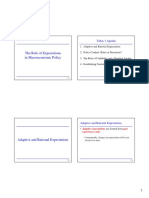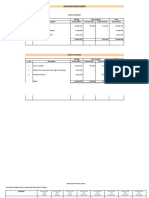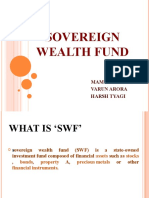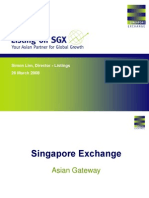Farmland Investment
Farmland Investment
Uploaded by
Agus AndriantoCopyright:
Available Formats
Farmland Investment
Farmland Investment
Uploaded by
Agus AndriantoCopyright
Available Formats
Share this document
Did you find this document useful?
Is this content inappropriate?
Copyright:
Available Formats
Farmland Investment
Farmland Investment
Uploaded by
Agus AndriantoCopyright:
Available Formats
Farmland investment: hedge agains... http://www.argentina-estancias.co...
Page 1 of 4
Farmland investment as inflation hedge in times of quantitave easing forest land as REDD investment
offers farmland Uruguay
. Peer Voss Rappstr.24 20146 Hamburg Germany tel +49-40457121 pvoss@pvoss.de Uruguay mobile 099-590922 Paraguay mobile 0981-543158
Hamburg / Montevideo August 2011
In these times, with money being printed on a global scale like never before in the last hundred years, it is even mo consider what assets have a truly intrinsic value, what assets are and will allways be of limited supply. So we talk a farmland. This is a brief and aproximate overview of the market from my point of view as a realtor for farmland in South Amer Peer Voss
farmer and farmland realtor in southern South America since 1997
Latin America In the central american and andean countries fertile farmland has never been too abundant, and some of those cou have restrictions in place re larger land holdings by foreigners. Foreigners have bought large tracts of land over the last two decades, due to low valuations and absence of restric - Brazil, the inner, or Cerrado states like Mato Grosso do Sul, Mata Grosso, Goais, Tocantins, western Bahia - Argentina - Uruguay - Paraguay - Bolivia, the eastern lowlands August 2011 market situation.
- Bolivia might be the country with the nominally cheapest land, due to leftist populist Evo Morales government and political violence and measures against large landholdings. Few people buy there currently and it is indeed a high r investment.
- The second lowest land valuations are found in Paraguay, and at decent price/value and chance/risk ratios. The m profitable farms (soya, sugar cane), intensivly operated and close to posessing plants currently cost US$3000cattle ranch land US$500-1500, virgin land forest covered in the semi arid Chaco region with good soil fertility costs per hectare. Most important buyers of land in the Paraguay Chaco are Agri Investors / farmers from Brazil and Uruguay followed buyers and western european investors. Uruguayan cattle rancher bought 700.000 hectare in the Paraguay Chaco until 2010 ( En 2010 se llevan vendidas m 100.000 hectreas a extranjeros Paraguay has the regions most favorable tax regime, 10% personal income tax, 10% VAT. On the down side Para rather low when it comes to transparency, quality of public services, rule of law. In other words it has many of the sh that characterise a third world country.
- Uruguay is in many aspects the opposite case. A mature civic society with strong rule of law and a distinctive euro Just it is not cheap any more. With US$5000-10000 per hectare for prime crop land (soya, corn, wheat), US$2500 hectare for good cattle pasture (which would include some minor fraction suitable for cropping) it is difficult to achie operational return above 4 or 5% anually as of 2011. Virgin land does not exist anymore in Uruguay. Income is taxed in the 15-25% range, VAT being 22% Political issue of foreign land holdings : Estimates of share of foreign hold land in Uruguay vary between 25 and 30% exist or are projected as of August 2011 to restrict it.
- Argentina is geographically and hence agriculturally very diverse. The heartland, the humid Pampa is comparable so is the price/value for farmland (though in Argentina some top fertility crop lands rank higher still in both price and then anything in Uruguay, costing up to US$15000/ha). Cropland in the tropical north, Formosa Province etc, costs around US$3000, cattle pasture land of medium produc
1/24/2012
Farmland investment: hedge agains... http://www.argentina-estancias.co...
Page 2 of 4
anywhere between US$1000 and 3000, best pasture lands (fattening) up to US$5000/ha Virgin land, with potential for profitable future farming/ranching start at US$300/hectare While argentinian income tax and VAT is within the regions typical rates, it levies an additional tax of around 20 exports like soya (not on the profit but on the revenue!), which weighs very heavy on producers. Some are leaving A of that reason. Political issue of foreign land holdings : Estimates of share of foreign hold land in Argentina vary between 10 and 15 (Dec 2011) a law passed parlament that limits the maximum of land a foreigner can purchase to 1000 hectare in the heartland, somewhat larger sizes in less fertile areas, and the maximum share of the nation's entire land to 15%, an single province, and to 15% of a single municipality. (existing land holdings are not effected)
- Brazil without wanting to discuss Brazil's land market, due to its sheer size and regional variations - legal practise significantly in 2010, restrictions now limiting the size of farm land foreign entities can buy. Limits range from 250 he densely populated intensively farmed regions like Sao Paulo to 5000 hectare in sparsely populated region like Ama Since law also puts a limit on total share of foreign owned land for each district, some district level governments ref permit, due to lack of knowledge how much land is foreign owned already. Again, as in Argentina, established land not effected. The law actually dates from 1971, just until recently there was not the political will to exercise it.
Other world regions Other countries exist where fertile farmland is cheap. Just foreigners can not be legal landowners (Russia, Ukraine, Sasketchewan and Manitoba of Canada). In Romania and Bulgaria fertile land was rather cheap for a brief period in but not so any more. In the vast majority of asian and african countries foreigners can not own farmland (just lease exception, and with low prices, would be South Africa but the the race and crime issue there is to be kept in mind. L western industrialised nations (including Australia and New Zealand) is too expensive to be discussed in this contex
Buyers of land have a basic decision to make - buy farmland and operate it oneself, disadvantage being a farmer is a profession not to be taken lightly and bein employer of local farm workers is not an easy task either, or - buy farmland and hire a management company to run it, disadvantage management fees may eat up significant profits, or - buy farmland and rent it out, rental return typically being in the 3% range, advantage requires less attention then above, and income being rather (though not 100%) predictable, or - buy raw land that has potential to be converted into farmland (land banking), advantage least attention required, disadvantage no operational return.
Land is the ultimate limited asset, more so then gold, where more of it is continously extracted from mines. The pur land investment would be to buy raw (virgin) land where you pay no premium for anything man-made (like buildings operational farm set up). But here the real analysis just starts. Over 90% of the worlds raw, idle lands will for ever stay that way, without com being deserts, semi deserts, montain ranges, or lands that should be left untouched due to environmental considera Virgin land with potential to be productive agricultural land soon, would have a favorable combination of climate, top fertility, environmental viability. If one looks for recreational potential, obviously scenery counts more. Land that is still virgin nowadays is so usually due to being remote, difficult to reach, so the extent of remoteness w another factor to constitute the value of raw land.
Virgin forest as carbon credit investment
A new aspect would be the holding of forest land as a REDD asset Discussing REDD carbon credits at this point is still highly hypothetical, but to do it anyway The global market for carbon credits (carbon offsets) is well established, liquid, with daily quotations, 1x metric ton o equivalent (tCO2e) costing US$15-20. It is however limited to projects that sequester carbon. It is being discussed t the future measures of "REduction of Deforestation and Degradation" (REDD). It basically means to grant credits fo cutting forests. A difficult issue will be how to quantify the value of not doing something One hectare of higher growth types of forest in the Paraguay Chaco might store 200t carbon. What might then be th environmental value of not cutting it ? 1/50 of that figure, equaling 4t CO2e ? Difficult to state. In such a case a fore might generate a gross income of US$60 or 80 per hectare per year through carbon credits. That is for an asset tha costs US$250.
1/24/2012
Farmland investment: hedge agains... http://www.argentina-estancias.co...
Page 3 of 4
Costs for certifying and marketing would still need to be deducted to calculate net income. Also countries where lan located might be inclined to tax such incomes substantially. View here a June 2009 ECONOMIST article "money grows on trees"
Gentleman Farmer's lifestyle and agriculture investment combined
The Pampa of Argentina and Uruguay with its benign moderate climate has for the last 150 years been a place whe landowners have built estate houses of both latin architecture with courtyards and open galleries or at times followin north western european manor style, their pastime being polo, horse races, hunting and at the same time often bein their field, introducing a new cattle race to the new world or a new crop variety. Their estates, the estancias measur thousand hectares. On and off, to this day a property, an estancia enters the market that allows for just that, a Gentleman Farmer's lifes agriculture investment combined. This would be one :
Uruguay - Estancia of the 1880s, 167 hectare cropland/rangeland - US$ 2,000,000
September 2011 : Investor's interest is far from having peaked yet, rather the opposite seems to be true : "Turmoil sends investors scrambling for havens - Farmland and gold seen as alternatives to Swiss franc" - a a Fina article on 10th.Sept.2011
(reset 06.07.2009)
1/24/2012
Farmland investment: hedge agains... http://www.argentina-estancias.co...
Page 4 of 4
1/24/2012
You might also like
- Agriculture in Uruguay - OverviewDocument43 pagesAgriculture in Uruguay - OverviewneerajpunjNo ratings yet
- International Farmland Market Bulletin: Investag SavillsDocument9 pagesInternational Farmland Market Bulletin: Investag Savillswegerg123343No ratings yet
- 2017 GLOBAL Aginvesting Conference: InsightsDocument12 pages2017 GLOBAL Aginvesting Conference: InsightsAnonymous 2X8yWQTNo ratings yet
- Gains From TradeDocument26 pagesGains From TradeSaumya RaizadaNo ratings yet
- Global Megatrends Part 6Document18 pagesGlobal Megatrends Part 6BustamanteAidalynNo ratings yet
- Putrajaya LIFT Festival 2019 Programme BookletDocument18 pagesPutrajaya LIFT Festival 2019 Programme BookletMarissa Estelle BahariNo ratings yet
- Institutional and Legal Frameworks For Public Debt ManagementDocument22 pagesInstitutional and Legal Frameworks For Public Debt ManagementAsian Development Bank - Event DocumentsNo ratings yet
- Financial ManagementDocument886 pagesFinancial ManagementKRISHNA PRASAD SAMUDRALANo ratings yet
- 2023 L1 FixedIncomeDocument117 pages2023 L1 FixedIncomezirabamuzale sowediNo ratings yet
- International Strategic ManagementDocument23 pagesInternational Strategic Managementmr_izzuNo ratings yet
- Derivatives Forwards + OptionsDocument102 pagesDerivatives Forwards + OptionsAK_ChavanNo ratings yet
- RandomVariables ProbDistributions CompleteDocument86 pagesRandomVariables ProbDistributions Completeshivam19920% (1)
- Mutual Fund WikipediaDocument12 pagesMutual Fund WikipediaDave ThreeTearsNo ratings yet
- TradeoffDocument20 pagesTradeoffaniketkaushikNo ratings yet
- Other DerivativesDocument70 pagesOther DerivativesProf. Suyog ChachadNo ratings yet
- Egypten Sektoranalyse Energy 2014Document6 pagesEgypten Sektoranalyse Energy 2014Adel ZahranNo ratings yet
- ME Cycle 8 Session 10Document76 pagesME Cycle 8 Session 10OttilieNo ratings yet
- cdf58sm Mod 3.1Document68 pagescdf58sm Mod 3.1vibhuti goelNo ratings yet
- PrivatecompanywaccDocument1 pagePrivatecompanywacckunaltiwari81No ratings yet
- Hong Kong Guide 2022-23Document83 pagesHong Kong Guide 2022-23Sandhya JaneNo ratings yet
- Morgan Stanley: Ka Him NG Kevin Yu Eric Long Ming ChuDocument116 pagesMorgan Stanley: Ka Him NG Kevin Yu Eric Long Ming ChuvaibhavNo ratings yet
- Dynamic of Global Commodity MarketsDocument20 pagesDynamic of Global Commodity Marketsharshm2311No ratings yet
- Finance Lesson 1Document5 pagesFinance Lesson 1JM BalanoNo ratings yet
- Slidestopic 2 LecDocument49 pagesSlidestopic 2 Lecwindows3123No ratings yet
- SM Cycle 7 Session 4Document76 pagesSM Cycle 7 Session 4OttilieNo ratings yet
- FRM Planner 2011Document2 pagesFRM Planner 2011bhanuchandarNo ratings yet
- Sampling Design and Analysis MTH 494 Lecture-32: Ossam Chohan Assistant Professor CIIT AbbottabadDocument119 pagesSampling Design and Analysis MTH 494 Lecture-32: Ossam Chohan Assistant Professor CIIT AbbottabadZahra HassanNo ratings yet
- Quiz 3Document131 pagesQuiz 3afeeraNo ratings yet
- Ronw Roce Fixed Assest T.ODocument45 pagesRonw Roce Fixed Assest T.Ofbk4sureNo ratings yet
- African Debt RestructuringDocument24 pagesAfrican Debt RestructuringMateus RabeloNo ratings yet
- 27 The Role of Expectations in Macroeconomic PolicyDocument10 pages27 The Role of Expectations in Macroeconomic PolicyP WinNo ratings yet
- Capital StructureDocument4 pagesCapital StructureSimran SidhuNo ratings yet
- SXSW V2venture ApplicationDocument22 pagesSXSW V2venture ApplicationMatthew MorrisNo ratings yet
- Development Innovation Ventures Sample Application September 2018Document12 pagesDevelopment Innovation Ventures Sample Application September 2018Mohamedi MirajiNo ratings yet
- Introduction To Financial ManagementDocument19 pagesIntroduction To Financial ManagementSaurabh AgrawalNo ratings yet
- A Presentation By: Joint Venture With Standard Life InvestmentsDocument156 pagesA Presentation By: Joint Venture With Standard Life InvestmentsaapkaskyNo ratings yet
- SME PLAN 1 - Globalnet TPA - Coral Basic Network ProviderList - Nov 2016Document33 pagesSME PLAN 1 - Globalnet TPA - Coral Basic Network ProviderList - Nov 2016Muhammad SiddiuqiNo ratings yet
- Relative Valuation: First PrinciplesDocument35 pagesRelative Valuation: First PrinciplesChad HallNo ratings yet
- Lecture1 IntroductionDocument74 pagesLecture1 Introductionyasmeen ElwasifyNo ratings yet
- CampbellDocument74 pagesCampbellAnonymous A8A7zTEmqNo ratings yet
- The Evolution of The International Monetary SystemDocument18 pagesThe Evolution of The International Monetary SystemQianfeng YinNo ratings yet
- Fra MindmapDocument10 pagesFra MindmapNghĩaTrầnNo ratings yet
- Corporate Finance Cap Structure 1Document140 pagesCorporate Finance Cap Structure 1Sabrina AlbaneseNo ratings yet
- A Study On The Growth in Assets and Composition of Mutual Funds Assets in IndiaDocument47 pagesA Study On The Growth in Assets and Composition of Mutual Funds Assets in Indiavinayjain221No ratings yet
- 5 Stages of A SPACDocument6 pages5 Stages of A SPACmichaelNo ratings yet
- Projects EstimatesDocument99 pagesProjects Estimatesketan100% (1)
- AMFI Mutual Fund (Advisor) Module: Preparatory Training ProgramDocument231 pagesAMFI Mutual Fund (Advisor) Module: Preparatory Training Programallmutualfund100% (5)
- Session 3 - RailwaysDocument12 pagesSession 3 - RailwaysGourab RayNo ratings yet
- ITS Module 2Document57 pagesITS Module 2Holy BankNo ratings yet
- Sovereign Wealth FundDocument11 pagesSovereign Wealth FundNiharika Satyadev JaiswalNo ratings yet
- Lecture 7Document23 pagesLecture 7Dis DeasNo ratings yet
- Cfa l1 CurrencyDocument35 pagesCfa l1 CurrencyRajesh ShahNo ratings yet
- PE With HQ in SGDocument12 pagesPE With HQ in SGZhang XuNo ratings yet
- A Financial Analysis of Monetary SystemsDocument13 pagesA Financial Analysis of Monetary SystemstymoigneeNo ratings yet
- Financing and Investment For Ports & TerminalsDocument4 pagesFinancing and Investment For Ports & TerminalsTimur ChairutdinovNo ratings yet
- Simon Lim, Director - Listings 26 March 2008: Singapore ExchangeDocument40 pagesSimon Lim, Director - Listings 26 March 2008: Singapore ExchangenetworkedNo ratings yet
- Chicago Board of Trade - (CBOT)Document10 pagesChicago Board of Trade - (CBOT)Debdoot MukherjeeNo ratings yet
- Lesson 05 - Fiscal Policy and StabilizationDocument48 pagesLesson 05 - Fiscal Policy and StabilizationMetoo ChyNo ratings yet
- ECO 343 Chapter 6Document3 pagesECO 343 Chapter 6alfie.hyettNo ratings yet
- Class 12th Economics Chapter-1Document8 pagesClass 12th Economics Chapter-1laxmiprabha2006No ratings yet
- Environmental Studies Question BankDocument30 pagesEnvironmental Studies Question BankmarigoldbloomsNo ratings yet
- MCQ Economics Ind Devt Ch1Document43 pagesMCQ Economics Ind Devt Ch1Jain AayushNo ratings yet
- USII.2a Physical Features and Climate-2Document10 pagesUSII.2a Physical Features and Climate-2Hailey ParkerNo ratings yet
- Project Proposal Solar ReaperDocument6 pagesProject Proposal Solar ReaperZeshan Sarwar100% (1)
- Agrivi - Providing Solutions To Feed The WorldDocument6 pagesAgrivi - Providing Solutions To Feed The WorldTesfaye DegechissaNo ratings yet
- Farmers Awareness and Risk Perception About ClimaDocument8 pagesFarmers Awareness and Risk Perception About ClimaDr. Muhammad ImranNo ratings yet
- Smart Agriculture System Poweredby Solar EnergyDocument67 pagesSmart Agriculture System Poweredby Solar EnergyabfstbmsodNo ratings yet
- Basics of BiochemistryDocument4 pagesBasics of BiochemistryKori Environmental Research ConsultancyNo ratings yet
- Checklist UPSCDocument17 pagesChecklist UPSCsabirjit943No ratings yet
- Biofuels Act of 2006Document15 pagesBiofuels Act of 2006quasideliksNo ratings yet
- IPA African Tulip Tree PP64Document2 pagesIPA African Tulip Tree PP64axy.axNo ratings yet
- AnanyaDocument15 pagesAnanyaanchalsh7890No ratings yet
- Philippine Vegetable Industry RoadmapDocument209 pagesPhilippine Vegetable Industry RoadmapJohn Paul Layola RabinaNo ratings yet
- Hygiea Case - Aira RoxasDocument5 pagesHygiea Case - Aira RoxasAira RoxasNo ratings yet
- Bodo Tribal People Agriculture Mathods and Its Various TypesDocument9 pagesBodo Tribal People Agriculture Mathods and Its Various TypessrimrinalhaloiNo ratings yet
- Lancrop Laboratories Soil TypesDocument2 pagesLancrop Laboratories Soil TypesHernando MontenegroNo ratings yet
- Global Food Security - FinalDocument34 pagesGlobal Food Security - FinalCatherine FetizananNo ratings yet
- Potential of Life Cycle Assessment To Support Environmental Decision Making at Commercial Dairy FarmsDocument11 pagesPotential of Life Cycle Assessment To Support Environmental Decision Making at Commercial Dairy FarmsNur HaziraNo ratings yet
- Zambia's Natural Capital Accounts: Informing Key Policy PrioritiesDocument36 pagesZambia's Natural Capital Accounts: Informing Key Policy PrioritiesmatijciogeraldineNo ratings yet
- Programme of Anarcho-Syndicalism: Grigori Petrovitch MaximovDocument80 pagesProgramme of Anarcho-Syndicalism: Grigori Petrovitch MaximovJames FiglioliNo ratings yet
- Literature Review For Mini ProjectDocument7 pagesLiterature Review For Mini Projectaflsmmmgx100% (1)
- LPM-Unit III-8 Economic Traits Sheep - GoatsDocument14 pagesLPM-Unit III-8 Economic Traits Sheep - GoatsSachin PatilNo ratings yet
- Fenvalerate 0.4 DP InsecticideDocument1 pageFenvalerate 0.4 DP InsecticideAman SandhuNo ratings yet
- Sample Unit GEO 3 ESODocument26 pagesSample Unit GEO 3 ESOmvallejoNo ratings yet
- Save Trees Save EarthDocument16 pagesSave Trees Save EarthUsman Tabish100% (10)
- Chapter - Iv Sugarcane Cultivation in IndiaDocument47 pagesChapter - Iv Sugarcane Cultivation in IndiaHimanshu MogheNo ratings yet
- Eddo 2020Document65 pagesEddo 2020temesgenNo ratings yet
- Universal Soil Loss Equation UsleDocument6 pagesUniversal Soil Loss Equation Usleabd_hafidz_1No ratings yet
- AUT Padi Kacang JagungDocument8 pagesAUT Padi Kacang Jagungahmad halimNo ratings yet

























































































